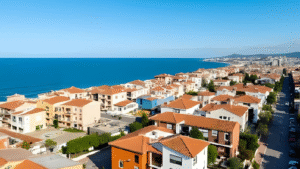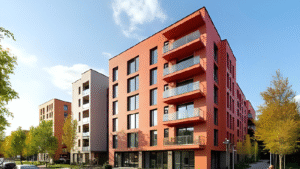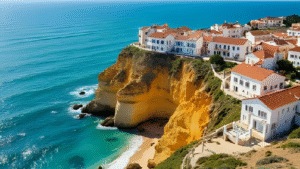Spain real estate trends indicate a significant transformation in the senior housing market, which is projected to double by 2030, resulting in the addition of up to 8,000 new apartments. This growth reflects the increasing demand for senior living solutions across the country.
Spain, renowned for its vibrant culture, stunning landscapes, and pleasant climate, is increasingly becoming a favored destination for retirees, particularly from other European nations. As the population of retired expatriates grows, so does the demand for specialized housing solutions tailored to their needs. According to a recent report by the real estate consultancy Colliers, the senior living housing market in Spain is poised for significant growth, with projections indicating that the supply of senior living units will double by 2030, reaching an estimated 8,000 apartments.
The Current Landscape of Senior Housing in Spain
As of now, Spain’s senior living model is still in its infancy, particularly when compared to more established markets such as the United States, the United Kingdom, and France. Currently, there are approximately 4,000 senior living units available in the country. Despite the favorable conditions for senior living—such as a high quality of life, affordable living costs, and a rich cultural and gastronomic landscape—the sector has yet to gain the traction seen in other European nations.
Colliers’ report highlights that Spain is one of the southern European countries with the highest potential demand for senior housing. The number of retired European citizens residing in Spain is expected to rise from 316,000 in 2024 to 415,000 by 2029, indicating a burgeoning market that is ripe for investment and development.
Factors Driving Growth in the Senior Housing Market
1. Increasing Retired Population
The primary driver of growth in the senior housing market is the increasing number of retired individuals choosing to relocate to Spain. The country’s appealing climate, coupled with its affordable cost of living, makes it an attractive option for retirees from northern European countries. As the population of retirees grows, so does the demand for suitable housing options that cater to their specific needs.
2. Quality of Life
Spain offers an enviable quality of life characterized by a mild climate, a relaxed lifestyle, and a rich cultural heritage. These factors contribute to the overall well-being of retirees, making Spain a preferred destination for those looking to enjoy their golden years. The availability of healthcare services, recreational activities, and social engagement opportunities further enhances the appeal of senior living in Spain.
3. Investment Opportunities
The last two years have seen a surge in joint ventures aimed at developing senior living projects across Spain. This influx of investment is crucial for the growth of the sector, as it brings in the necessary capital and expertise to create high-quality living environments for seniors. However, the challenge remains in finding experienced operators who can effectively manage these facilities and ensure a high standard of care.
Regional Demand Concentration
Colliers’ report indicates that demand for senior living units will be particularly concentrated in coastal regions such as the Valencian Community, Andalusia, Murcia, and the Balearic Islands. These areas already have a significant presence of retired European citizens, making them prime locations for the development of senior housing projects. The allure of coastal living, combined with the availability of amenities and services tailored to seniors, positions these regions as hotspots for future investment.
Coastal Regions: The New Frontier for Senior Living
The coastal regions of Spain offer not only beautiful landscapes but also a lifestyle that many retirees find appealing. The Valencian Community, for instance, boasts a Mediterranean climate, stunning beaches, and a rich cultural scene. Similarly, Andalusia is known for its historical significance, vibrant festivals, and culinary delights. These factors contribute to the desirability of these regions for retirees seeking a fulfilling and enjoyable lifestyle.
Challenges Facing the Senior Housing Market
1. Lack of Experienced Operators
Despite the promising growth projections, the senior housing market in Spain faces significant challenges. One of the most pressing issues is the shortage of experienced operators who can manage senior living facilities effectively. The success of these projects hinges on the ability to provide high-quality care and services, and the current lack of expertise in the market poses a risk to the sector’s growth.
2. Regulatory Hurdles
Navigating the regulatory landscape can also be a challenge for developers looking to enter the senior housing market. Local regulations regarding construction, zoning, and healthcare services can vary significantly from one region to another, complicating the development process. Developers must be well-versed in these regulations to ensure compliance and avoid potential setbacks.
3. Market Education
Another challenge is the need for market education. Many potential investors and developers may not fully understand the nuances of the senior living market or the specific needs of retirees. Educating stakeholders about the benefits and opportunities within this sector is essential for fostering growth and attracting investment.
The senior housing market in Spain is on the brink of a significant transformation, with projections indicating that the supply of senior living units will double by 2030. As the number of retired expatriates continues to rise, driven by Spain’s favorable living conditions, the demand for specialized housing solutions will only increase. However, for this growth to be realized, the sector must address several challenges, including the shortage of experienced operators, regulatory hurdles, and the need for market education.
As Spain positions itself as a leading destination for retirees, the development of a robust senior living market will not only enhance the quality of life for seniors but also contribute to the overall growth of the real estate sector. Investors and developers who recognize the potential of this burgeoning market will be well-positioned to capitalize on the opportunities that lie ahead. With the right strategies and investments, Spain’s senior housing market can evolve into a thriving sector that meets the needs of its growing retired population.









